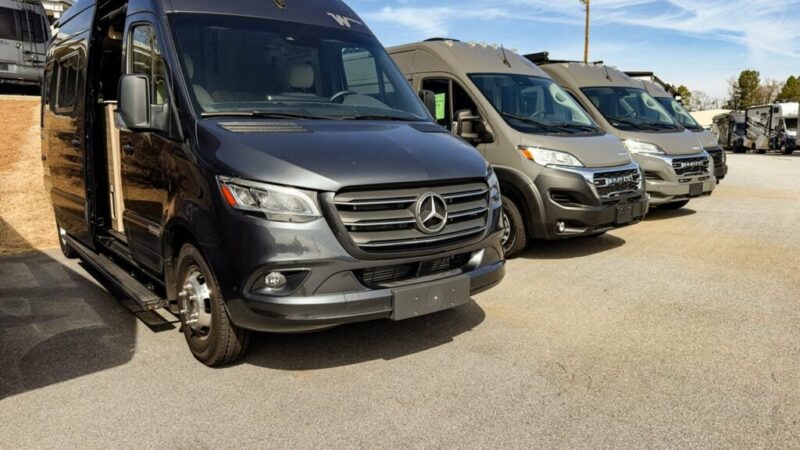How to Pick the Perfect e-bike for RV Life
Electric bikes (e-bikes) are revolutionizing RV life. They offer the freedom to explore without the hassle of driving and then finding a place to park. That said, it’s far easier to navigate many small towns on an e-bike than in a vehicle, because you can ride them where other vehicles can’t go. Plus there’s no need to cruise overflowing parking lots to find a place to park an e-bike. Instead, you can just find a convenient bike rack.
However, getting around on an e-bike instead of driving has another big benefit. As we get older, exercise options become increasingly limited. That said, riding an e-bike offers a low impact exercise that’s actually fun whether you’re young or old. However, with the ever-growing myriad of fantastic looking folding e bikes available, it can be hard to decide which one will suit your needs. This guide will help you navigate the choices to find the perfect e-bike for RV life.
Why a Folding e-bike is a Must-Have for RVers
Folding e-bikes have some key benefits over other e-bikes when it comes to RV life. They boast the same advantages, but they’re more convenient and compact than other e-bike options. That said, you can fold them for storage inside the RV, in an exterior cabinet, or in the back of a tow vehicle. This means you don’t need to buy an e- bike rack to bring your e-bike on road trips. But they can also ride on a bike rack on the back of the RV or a towed vehicle too.
This makes folding ebikes a versatile option for a mobile lifestyle that often demands versatility. These nimble little bikes often have all-terrain tires that enable you to explore places you wouldn’t ordinarily see. Although they provide the same environmental benefits and power as bigger e-bikes, folding e-bikes take up less room. The only downside of folding e-bikes is that they’re often heavier than other e-bike types and they aren’t usually available with rear suspension.
Key Considerations When Choosing an e-bike
Weight
Weight can be a deciding factor in whether an ebike is a good choice for your needs. That said, while there’s no doubt that folding e-bikes are very compact, they often weigh between 60 and 80 lbs. This can make them a challenge to load into the RV or basement storage areas. It can also make them difficult to lift into the back of a tow vehicle or onto a bike rack. For these reasons, it’s a good idea to get an e-bike that is well under the weight that you can safely lift If you’ll be carrying your e-bike on a bike rack, be aware of the bike rack (and hitch) weight capacity.
DImensions
Knowing the folded and unfolded length and width of an e-bike will allow you to find a suitable storage spot for transporting it.
Power and Performance
Power and performance is what makes e-biking fun. That said, you’ll want enough power to get up hills. Power is affected by load, so the heavier you are, the less power you’ll get from your bike. That said, many people find that a folding e-bike with a 500-watt motor gives them plenty of power. However, if you’re heavier, or intend to use your bike for climbing hilly terrain or carrying the occasional basket of groceries home from the store, you’ll probably be happier with a 750-watt motor on your e-bike.
Motor Type
There are two types of motors used on e-bikes. Whether you choose a bike with a hub motor or mid-drive motor will depend on your priorities. Hub motors are located in the rear wheel hub. They’re the simpler, lighter and more affordable option. However, mid-drive motors offer better torque, which can be handy on hilly terrain or in more demanding riding conditions. That said, they’re heavier, more complex, and more expensive.
Battery
Since the e-bike battery stores the energy needed to run the motor, the battery size will determine its range. Battery capacity is measured in watt hours but range-per-charge will be given in miles or kilometers. Unless you want to charge the battery frequently, look for an e-bike with battery of 400 watt-hours or higher.
Weather Proofing
Batteries on e-bikes are can be damaged by moisture if they aren’t built and treated with some level of waterproofing. Therefore another consideration when choosing an e-bike is the level of battery waterproofing. Waterproofing is rated with an IP rating. With that said, e-bikes that have batteries with an IP rating of IPX6 will withstand being sprayed when you wash your bike. A battery with an IP rating of IPX7 or more will withstand being submerged in water, which can save your bike if it gets submerged in water.
In addition, other components on some e-bikes, such as the LED screen are IP rated as well. A minimum of IPX6 will allow you to ride in the rain or wash your bike without issue.
Pedal Assist and Throttle
PAS or Pedal assist engages the motor when you pedal, whereas a throttle allows the rider to activate the motor without pedaling. Pedal assist levels let you choose how much work your bike’s going to do and how much work you’re going to do. The higher the pedal assist level, the more work the bike will do. Of course, riding with higher PAS levels or in throttle mode drain your battery the fastest.
Lights and Turn Signals
Most e-bikes come with a headlight and tail light. In addition, some also have brake lights and turn signals, so you can let other riders and drivers know what you’re about to do. This feature saves the rider from having to use hand signals when riding in traffic.
Ride Comfort and Safety
Almost all folding e-bikes are built with some level of rider comfort in mind. That said, an ebike with an adjustable front shock, or at least a lockout will help to maximize your comfort. All terrain tires will help to stabilize the bike, especially in wet or slick conditions. Other things to look for are and adjustable stem and (of course) a comfortable seat.
Accessory Ports and Rack
Bike frames usually feature holes in the seat tube and other places for attaching accessories like a water bottle holder or a cargo basket or panniers on the rear rack. Almost all folding e-bikes have a rack on the back for carrying everything from child carriers to cargo baskets.
UL Safety Certifications
You’ve probably heard at least one story of a lithium e-bike battery that exploded or caused a fire due to being overcharged. Some e-bike companies are mitigating this risk by having their ebikes certified by Underwriters Laboratories (UL). UL issues safety certification for an e-bike after performing rigorous testing on it. They want to make certain the e-bike meets specific safety standards, as an assurance that it won’t be a fire, electrical, and shock hazard risk. UL certification offers assurance that your e-bike won’t become a threat to life and limb.
That said, even when an e-bike is UL certified, you’ll still need to monitor the battery as it’s charging and unplug it as soon as it’s charged to capacity. Lithium e-bike batteries are also heat sensitive, so keeping your bike out of direct sunlight is also a good safety practice.
Security Features
Many e-bikes come with features like Apple Find My Device tracking and/or keyed start. However, having a good bike lock can help prevent a thief from walking away with your bike while you’re enjoying lunch at a cozy restaurant.
Brand Reputation
Folding e-bikes are expensive, so it’s a good idea to go online and thoroughly research brands before you buy one. Here are some places to find out what others are saying about a brand.
- Reddit e-bikes
- Facebook e-bike enthusiasts
- Online Bicycling magazines
- Youtube e-bike review channels
- irv2 Forums
Conclusion
e-bikes are a perfect fit for RV life. They offer eco-friendly transportation, fun, low-impact exercise for people of all fitness levels, and are a great way to explore new places. A folding e-bike makes storage for transportation marvelously simple, with or without a bike rack because they can fold up to be stored inside the RV or tow vehicle.
The post How to Pick the Perfect e-bike for RV Life appeared first on RV LIFE.
Source: https://rvlife.com/how-to-select-the-perfect-e-bike-for-rv-life/






